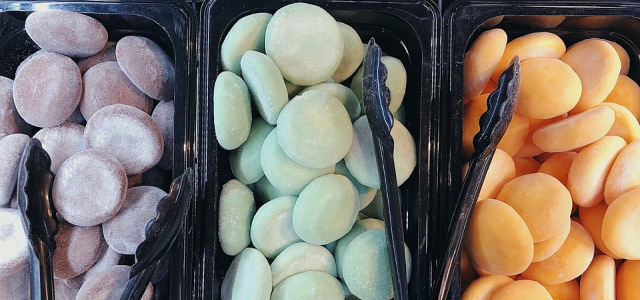 There are several dangerous myths circulating about trademarks and how they work. One of the myths I encounter most often relates to likelihood of confusion analysis. Trademark owners, especially small business owners, commonly believe that if their products or services are not exactly the same as the ones offered by someone with a similar mark, then they are in the clear – there is no possible likelihood of confusion. I hear this most often when someone files their own trademark application, receives a refusal, and contacts me about taking on their case and overcoming the refusal. The protest is usually something like: “But I’m not even selling the same thing they are!”
There are several dangerous myths circulating about trademarks and how they work. One of the myths I encounter most often relates to likelihood of confusion analysis. Trademark owners, especially small business owners, commonly believe that if their products or services are not exactly the same as the ones offered by someone with a similar mark, then they are in the clear – there is no possible likelihood of confusion. I hear this most often when someone files their own trademark application, receives a refusal, and contacts me about taking on their case and overcoming the refusal. The protest is usually something like: “But I’m not even selling the same thing they are!”
Likelihood of confusion issues (and this common misconception that non-identical goods or services obviate such issues) pop up in the context of both prosecuting trademark applications and dealing with court disputes over trademark infringement. The Section 2(d) likelihood of confusion refusal is the most common grounds cited by the U.S. Patent and Trademark Office (USPTO) for a substantive refusal of a trademark application. And in a U.S. court of law, when a trademark owner sues someone else for trademark infringement, they must show, among other things, that the way in which the defendant uses the mark causes a likelihood of confusion.
In fact, I was reminded of this myth most recently not when responding to a USPTO refusal but when reading about a dispute between two New York City sweets shops. The owners of MOCHIDOKI, a shop selling ice cream, sued the owners of MOCHI DOLCI, a shop selling doughnuts and bubble tea. In a video on the New York Post’s website, one of the co-owners of MOCHI DOLCI laments: “We don’t sell mochi ice cream, we sell mochi doughnuts, and we’re not going to change the name . . . I gotta get a lawyer to tell them that I’m not making mochi ice cream.”[1]
The frustration is real, but the idea that different products or services automatically translates to no infringement or no application refusal – that is a myth. A trademark user can infringe someone else’s trademark rights even if they are not offering identical products or services. An application to register a mark can be refused based on a likelihood of confusion even if the applicant is not offering products or services identical to those in the registration that is blocking them.
The likelihood of confusion analysis looks a little different when arguing against the USPTO’s refusal of a trademark application than when two trademark users battle in court over who has superior rights. But there is significant overlap, and the primary inquiry in either case boils down to whether consumers are likely to be confused about the source of the products or services offered under these marks. Are they going to think they are getting these things from the same company when, in fact, they are getting them from two separate companies?
In the example of the sweets shop owners, what we want to know is, if a consumer buys a doughnut at MOCHI DOLCI and a few days later buys some ice cream at MOCHIDOKI, are they likely to think that doughnut and ice cream came from the same source (maybe 2 different locations of the same chain)? And when we think through that, we have to take into account that most consumers have a memory that is less than perfect or photographic.
There are several factors that help us figure out whether consumers are likely to be confused. One of those is how closely related the products or services are. In the context of arguing against refusals of trademark applications based on a likelihood of confusion, we typically focus in on the following questions.
(1) Can consumers commonly buy both products in the same place? By “the same place,” I do not mean a big box store like Costco, Walmart, or Target. Consumers can buy such a wide variety of products in stores of this kind that if we said products sold within such stores are related, that would have the practical effect of making almost everything related for likelihood of confusion purposes. We have to look at stores with a narrower focus. For example, if one party uses their mark with ice cream and the other party uses their mark with doughnuts, we might ask whether consumers can commonly buy both ice cream and doughnuts in the same sweets shop. If they can, consumers are more likely to be confused.
(2) Are both products commonly sold under the same mark? Sticking with our example of ice cream and doughnuts, if I can buy both products at the same sweets shop, but those two products usually are sold under different brand names, consumers are less likely to be confused. But if those two products usually are sold under the same brand name, then consumers are more likely to be confused.
(3) Are the same groups of people buying both products? Sometimes, there are arguments about exactly which groups (or classes) matter. If the relevant products are ice cream and doughnuts, how broadly or narrowly do we define that class of consumers? From the USPTO’s perspective, unless the application or registration limits the class of consumers, it is presumed that the products are available to all classes of consumers. If the people buying doughnuts and the people buying ice cream both fall within the same category, then consumers are more likely to be confused.
Bear in mind, the (un)relatedness of the goods or services is just one factor among several to be weighed in a complete likelihood of confusion analysis. Even if we finally decide that ice cream and doughnuts are closely related, we still have to answer several more questions including whether the marks being used with these goods are confusingly similar.
Ultimately, we need to remember that the rules of trademark law are far from intuitive. And we should be prepared to help clients understand that they may still encounter trouble in the form of liability for infringement or application refusals even if the other trademark user or registration holder claims use of their mark with different products or services.
[1] https://nypost.com/2023/01/07/nyc-dessert-shops-in-trademark-tiff-federal-lawsuit/.
Written by Dana Dickson, Founder, Dana Dickson Law
| MORE NEWS | | SHARE NEWS WITH OUR EDITOR |











